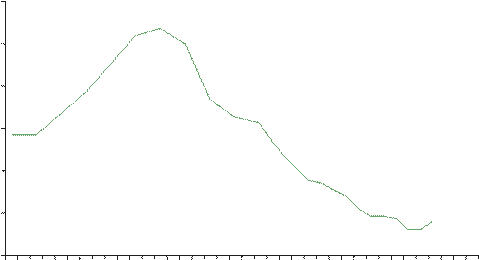 |
FINDINGS. Theft of Vehicles. Security and the drop in car theft
|
|
|
|
FINDINGS
Rather than attempting to understand the overall crime trend, we decided to focus on individual crime types, notably those that had fallen most substantially, to determine whether findings support or contradict the security hypothesis.
Theft of Vehicles
 600
600
Jan ‘81
Jan ‘83
Jan ‘87
Jan ‘91
Jan ‘93
Jan ‘95
Jan ‘97
Jan ‘99
Apr Apr Apr Apr Apr Apr Apr Apr Apr Apr Apr Apr Apr Apr Apr ‘01 ‘02 ‘03 ‘04 ‘05 ‘06 ‘07 ‘08 ‘09 ‘10 ‘11 ‘12 ‘13 ‘14 ‘15
to to to
to to
to to
to to
to to
to to to
to to to
to to
to to to to
Dec ‘81
Dec ‘83
Dec ‘87
Dec ‘91
Dec ‘93
Dec ‘95
Dec ‘97
Dec ‘99
Mar Mar Mar Mar Mar Mar Mar Mar Mar Mar Mar Mar Mar Mar Mar ‘02 ‘03 ‘04 ‘05 ‘06 ‘07 ‘08 ‘09 ‘10 ‘11 ‘12 ‘13 ‘14 ‘15 ‘16
FIgure 10. 2 Trend in numbers of thefts of motor vehicles CSEW 1981–2016
Source: Crime Survey of England and Wales, Office for National Statistics
Security and the drop in car theft
We began with theft of motor vehicles, which increased rapidly for decades before the 1990s but has since dropped by over 80%. Figure 10. 2 shows the trend, as found in the CSEW.
The CSEW asks some questions that allowed us to see whether the changing pat- terns of car theft accorded with what would be expected were improvements in vehicle security to be playing a significant role (Farrell et al., 2011a). It asked about the security to the cars that respondents drove. If there were, indeed, no security improvements, then that would put paid to the security hypothesis. However, suc- cessive sweeps of the survey showed increasing levels of security. The survey also
asked how the thief gained entry. If security were important, we reasoned that the fall would be felt most acutely in relation to methods that required that security be overcome and least where methods did not require that security be overcome. This is, indeed, what the series of CSEW sweeps showed. Security improvements to vehi- cles do not make vehicles impossible to steal, albeit they may make their theft more difficult (improved door locks, better window locks, electronic immobilisers), more risky (alarms), and also make the use of security more routine (central locking). Given this circumstance, we thought that younger, less experienced offenders would be more easily stopped by security. Consistent with this, the CSEW showed that temporary theft – where the car is returned because it was used for joyriding or transportation by young people – fell much more initially than did permanent theft (by more experienced offenders stealing to sell parts or re-sell the car). We also know that there was continual improvement to security devices, particularly the electronic immobiliser, and consistent with this there was also a major reduction in permanent theft over time. At the time of writing, joyriding is largely extinct and more organ- ized theft has fallen by three quarters. However, a recent uptake in thefts of high-end vehicles such as Range Rovers suggests manufacturers need to continue to improve security to stay ahead of thieves (Brown, 2017).
|
|
|
We looked to a different, Australian data set, to explore our hunch that electronic
 immobilisers had played an especially important part in producing the fall in car theft that had been observed in many countries. The Comprehensive Auto-theft Research System (CARS) data set collects details of every car theft reported to the Australian police (and it is worth remembering that rates of reporting car theft are especially high, given insurance requirements). In Australia, a ‘ natural experiment ’ occurred in relation to immobilisers and car thefts. Western Australia, one of the six Australian states, legally required electronic immobilisers to be fitted some years before the rest of the country. We found that the decline in car theft began earlier in Western Australia than the rest of the country but that both declines corresponded with the timing of the immobiliser legislation, corroborating our security hypothesis (Farrell et al., 2011a).
immobilisers had played an especially important part in producing the fall in car theft that had been observed in many countries. The Comprehensive Auto-theft Research System (CARS) data set collects details of every car theft reported to the Australian police (and it is worth remembering that rates of reporting car theft are especially high, given insurance requirements). In Australia, a ‘ natural experiment ’ occurred in relation to immobilisers and car thefts. Western Australia, one of the six Australian states, legally required electronic immobilisers to be fitted some years before the rest of the country. We found that the decline in car theft began earlier in Western Australia than the rest of the country but that both declines corresponded with the timing of the immobiliser legislation, corroborating our security hypothesis (Farrell et al., 2011a).
Our applied interest led us to ask exactly what it was about security that was ren- dering vehicles less vulnerable to theft. For this, we devised the ‘Security Impact Assessment Tool’ (SIAT) with which we calculated the Security Protection Factor (SPF) (see Box 10. 2).
Our findings corroborated the importance of electronic immobilisers in protecting against the theft of vehicles. We found that having a suite of security devices was the most effective – combinations of devices had larger SPFs than would be expected by simply summing the scores of each on its own. So, there is added value in producing vehicles that are generally inhospitable to the prospective offender (Farrell et al., 2011b). We also found, for both car crime and burglary (discussed below), that attempted crimes continued at a higher level for two to four years after completed crimes began to fall, suggesting offenders continued to try before being deterred by improved security (Farrell, 2016).

 The core set of quantitative data signatures that we have identified relating to vehicle-related theft and the role of security are summarized in Table 10. 1. All of the signatures are consistent with security being the cause of the decline in vehicle-related theft.
The core set of quantitative data signatures that we have identified relating to vehicle-related theft and the role of security are summarized in Table 10. 1. All of the signatures are consistent with security being the cause of the decline in vehicle-related theft.
TaBle
10. 1 Quantitative data signatures consistent with security having reduced
vehicle-related theft
 |
• The timing and spread of security fits with the trajectory of declines in vehicle-related theft in different countries
• Different security devices impact differently against different crime types, consistent with their preventive mechanisms
• Preventive effects are much stronger when multiple security devices are in place
• The average age of stolen vehicles increased over time when crime fell, because new vehicles have better security
|
|
|
• There were quicker and larger effect on temporary theft (joyriding, transportation) than on permanent theft (for re-sale or chopping)
• Offenders’ modus operandi changed, with door lock forcing declining disproportionately, consistent with better quality deadlocks.
• Vehicle theft fell somewhat more quickly among higher income groups, consistent with the more rapid replacement of older insecure vehicles
• The rate of attempted theft fell later than completed theft, consistent with offenders continuing to try before quitting in the face of improved security
• There was a disproportionate decline in adolescent crime, consistent with novices being more easily deterred by improved security
•
 |
In Australia and Canada, car theft fell earlier in regions that introduced electronic immobilisers earlier, then fell nationally in line with their broader spread.
Of course, security increases in relation to vehicles are not confined to the vehicles themselves. The vehicles have to be stolen from somewhere, and security at parking places is important. In particular, car parks can be more or less secure. There is some evidence that closed circuit television (CCTV) in car parks reduces the rate at which cars are stolen from them (Tilley, 1993; Welsh and Farrington, 2008). Other features of car parks may make them less or more secure, including lighting, barriers and openness to surveillance by businesses based in them. However, while we know car park security is important, to date we have not identified a data source and way of gauging whether or not improved security at car parks contributed significantly to the drop in vehicle-related theft.
We published our findings on security and car theft and they have been corrobo- rated by other researchers studying in other countries (Bä ssmann, 2011; Brown, 2015; Fujita and Maxfield, 2012; van Ours and Vollaard, 2016). The methodologies applied in these studies varied widely: triangulation of different US data and simple correlation of time series (Fujita and Maxfield, 2012); a mixed methods approach, involving quantitative descriptive trends analyses (with year-on-year changes) and findings from expert interviews in Germany (Bä ssmann, 2011); (log-linear) regres- sion of over 15 years’ data on specific car makes to estimate the overall effect size of the EU-wide intervention on car immobilisers, accounting for age and other car characteristics as well as displacement; and meta-analysis of a number of studies from four countries (the UK, Germany, Australia and the USA) on the impact of electronic immobilisation on vehicle theft. Including our own initial study, three in total employed triangulation investigating the data signatures on any effect of immobilis- ers on car crime reduction (Bä ssmann, 2011; Farrell et al., 2011b; Fujita and Maxfield, 2012); one also employed qualitative methodology; another advanced statistical modeling; and a third examined all the above via meta-analysis.
|
|
|


